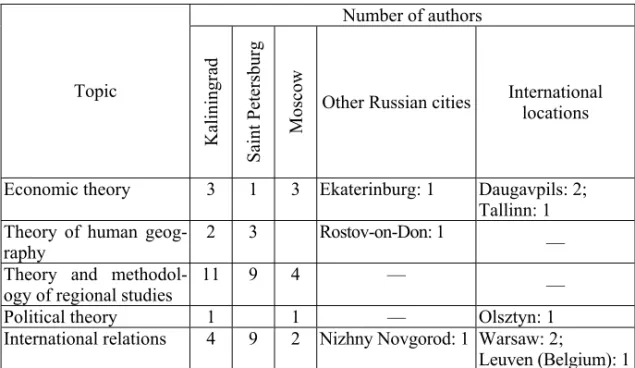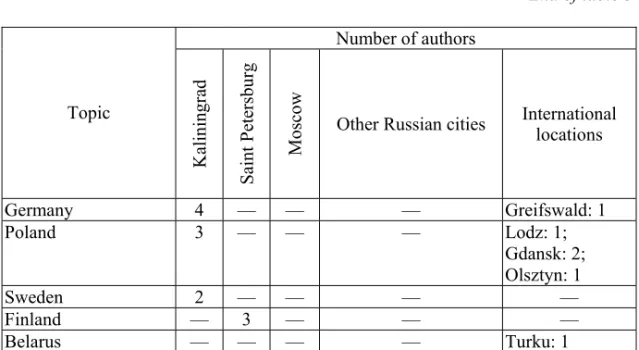A.P. Klemeshev
Co-chair of the Editorial Council of the Baltic Region Journal
BALTIC SEA REGION STUDIES: CURRENT TRENDS (Based on Publications in the Baltic Region Journal)
The Baltic region is a traditional research subject for scholars from Saint Petersburg and Kaliningrad — the two Russian research centres on the Baltic coast. In 2009, the Immanuel Kant Baltic Federal University in collaboration with Saint Petersburg State University established the Baltic Region aca-demic journal. The journal’s editorial council and editorial board bring to-gether prominent experts from Russia and the other Baltic region states — Germany, Latvia, Lithuania, Poland, and Finland.
The journal has become a platform for expert commentary on Baltic is-sues with a focus on the geopolitical, socioeconomic, cultural, and environ-mental processes taking place in the macroregion. The journal publishes findings of national and international experts in regional economy, human geography, political regional studies, history, and geoecology. Theoretical works appear on the pages of the journal alongside contributions dedicated to the Baltic region.
The Baltic region is published both in Russian and in English. In 2010, it was included in the list of Russian journals recommended by the Higher At-testation Commission, a national advanced degree awarding organization. In
the beginning of 2015, the journal became part of the Core Collection
(Emerging sources citation index) of the Web of Science system.
Twenty-nine issues of the journal have been published so far (autumn 2016) with a total of 327 articles, including reports and review and excluding editorials. The IKBFU researchers have authored 134 and co-authored 12 con-tributions. Scholars from Saint Petersburg State University have published 75 articles and co-authored seven. Forty-one articles have been contributed and 12 co-authored by Moscow experts. Researchers from other Russian ci-ties have prepared 13 and co-authored two publications. International scho-lars have authored 47 and co-authored eight articles (table 1).
Table 1
Geography of Authors Contributing to the Baltic Region (29 issues)
Research centre Number
of articles Additional information
Kaliningrad 134 —
Kaliningrad and Saint Petersburg 2 —
End of table 1
Research centre Number
of articles Additional information Kaliningrad, Moscow and other
Rus-sian centres
1 Rostov-on-Don: 1
Kaliningrad and international cen-tres
6 Germany: 3; Poland: 3,
Saint Petersburg 75 —
Saint Petersburg and Moscow 1 —
Saint Petersburg and other Russian centres
2 Nizhny Novgorod: 1; Omsk: 1
Saint Petersburg and international centres
2 Germany: 1; Netherlands: 1
Moscow 41 —
Other Russian centres 13 Pskov: 3; Murmansk: 1; Petroza-vodsk: 2 + 1; Nizhny Novgorod: 2; Rostov-on-Don: 2; Ekaterinburg: 1; Orenburg: 1; Krasnoyarsk: 1
International centres 46 Poland: 11; Lithuania: 9; Latvia: 9; Estonia: 2, Germany: 6; Sweden: 1; Denmark: 1, Finland 5; Belgium: 1; Spain: 1
International centres (three coun-tries)
1 Germany, Latvia, Estonia
A given issue of the journal includes an average of ten research articles focusing on the methodological and applied problems of the development of the Baltic macroregion, as well as theoretical works in relevant areas of re-gional studies.
The major research topics of the journal’s articles are as follows.
Table 2
Distribution of Theoretical Articles by the Author’s City of Residence
Number of authors
Topic
Kalin
ing
rad
Sain
t Petersbu
rg
Mo
sco
w
Other Russian cities International locations
Economic theory 3 1 3 Ekaterinburg: 1 Daugavpils: 2; Tallinn: 1 Theory of human
geog-raphy
2 3 Rostov-on-Don: 1
—
Theory and methodol-ogy of regional studies
11 9 4 —
—
Political theory 1 1 — Olsztyn: 1
International relations 4 9 2 Nizhny Novgorod: 1 Warsaw: 2; Leuven (Belgium): 1
2) Articles on the economy of Russia and northwestern Russian territo-ries, primarily those situated in the Baltic region (table 3).
Table 3
Distribution of Articles on the Economies of Baltic Region States and Territories by the Author’s Place of Residence
Number of authors
Topic
Kalin
ing
rad
Sain
t Petersbu
rg
Mo
sco
w
Other Russian cities International locations
Russian economy 3 — 1 Nizhny Novgorod: 1 Turku: 1 North-West Russia
(ex-cluding the Kalinin-grad region)
3 10 — Pskov: 1; Petrozavodsk: 3; Krasnoyarsk: 2
—
Kaliningrad region 28 1 8 Nizhny Novgorod: 1; Omsk: 2
Olsztyn: 2; Vilnius: 2
Baltic states 9 3 3 — Riga: 2;
End of table 3
Number of authors
Topic
Kalin
ing
rad
Sain
t Petersbu
rg
Mo
sco
w
Other Russian cities International locations
Germany 4 — — — Greifswald: 1
Poland 3 — — — Lodz: 1;
Gdansk: 2; Olsztyn: 1
Sweden 2 — — — —
Finland — 3 — — —
Belarus — — — — Turku: 1
The works of five Russian and one international (Turku, Finland) authors have been dedicated to the current problems of Russian economy.
The Russian North-West and its regions (excluding the Kaliningrad re-gion) is intensively studied by scholars from Saint Petersburg. Several works have been published by authors from
Kaliningrad, Pskov, Petrozavodsk, and even the remote city of Kras-noyarsk.
Naturally, most works focus on the development problems of the Kalin-ingrad region since the journal is published in KalinKalin-ingrad and the surround-ing region — a Russian exclave with unique natural and socioeconomic con-ditions — is an area of special research interest. There are dozens of differ-ent strategies for the region’s socioeconomic developmdiffer-ent prepared by both Russian and international experts. Kaliningrad regional issues have been ex-amined in the works of 28 authors from Kaliningrad, eight from Moscow, one from Saint Petersburg, four from other Russian cities, and four from abroad.
The Baltics account for most international publications. Current prob-lems of the Baltics development have been studied by both Baltic and Kalin-ingrad scholars. Several articles have been published by researchers from Moscow and Saint Petersburg. There are articles focusing on Germany, Po-land, Sweden, FinPo-land, Lithuania, Latvia, and Belarus, the latter sometimes considered part of the Baltic region. The only two countries that have not been examined yet on the pages of the journal are Denmark and Estonia.
3) Individual aspects of Baltic development
security, education system development, demographic changes, environ-mental problems, and regional development strategies, account for most arti-cles authored by contributors from different cities and countries.
Table 4
Distribution of Articles on the Baltic Region by the Author’s Place of Residence
Number of authors
Topic
Kalin
ing
rad
Sain
t Petersbu
rg
Mo
sco
w
Other Russian cities
Foreign cities
Baltic region: state know-ledge, history, economy, spatial organisation
9 1 — — Bonn: 1;
Daugavpils: 1
Baltic region: energy and energy security
6 7 5 — Vilnius: 2;
Kaunas: 1;
Arnhem (Netherlands): 1 Baltic region: educational
system
12 6 — Murmansk: 2 Greifswald: 1; Daugavpils: 3 Baltic region: tourism 3 — — Petrozavodsk: 1 —
Population: theory 1 — 1 — —
Baltic region: population 4 7 6 Pskov: 3 Daugavpils: 1; Gdansk: 1;
Wiesbaden (Germany): 1
Europe: migration — 3 — — —
Latvia: migration — — — — Bamberg (Germany): 1; Riga: 1;
Tartu: 1 Kaliningrad region:
migra-tion
3 — — — —
Ecology and environmen-tal protection
4 12 7 — Berlin: 1;
Kiel: 1 Baltic region: development
strategy
4 5 3 — Bonn: 1;
Copenhagen: 1; Gdynia: 1
Theoretical and methodological aspects have been discussed by nine Ka-liningrad authors. The same number of authors focus on innovations in the Baltic region. This aspect has been examined by two authors from Saint Pe-tersburg, one from Moscow, and one from Turku.
Innovations in the Kaliningrad region have been studied by seven Kalin-ingrad authors and the potential of international innovative cooperation in the Baltic by eight. One article has been published by a contributor from Kiel (Germany).
5) International cooperation
Strengthening of intergovernmental and interregional cooperation in the Baltic region is a major topic, which has been addressed in the journal by both national and international authors (table 5). In this context, contributors examine acute problems adversely affecting the development of transna-tional and transboundary relations. Russian scholars stress that Lithuania, Latvia, and Estonia are severing economic ties with Russia even at the ex-pense of their own economies. Their proportion in Russia’s international trade is constantly decreasing. There are social problems and ethnic tensions. The Baltics are deploying new NATO objects, which produces an expectedly negative reaction from Russia. All this has complicated the introduction of new forms of economic organisation as per previous proposals.
Table 5
Distribution of Articles on Baltic Cooperation by the Author’s Place of Residence
Number of authors
Topics
Kalin
ing
rad
Sain
t Petersbu
rg
Mo
sco
w
Other Russian cities
International locations
Russia’s relations with the other Baltic region states
3 3 1 — Klaipeda: 1
International cooperation 12 3 6 — Augsburg: 1; Warsaw: 1; Barcelona: 1 Transboundary
coopera-tion
16 11 5 Nizhny Nov-gorod — 1
Despite certain political tensions between Russia and the other regional countries, the journal keeps contributing to cementing ties between scholars studying the Baltic Sea region. A series of research conferences and work-shops on the Baltic issues have been held, including the ‘Baltic studies in Russia’ international conference (April 22—23, 2016), the proceedings of which have later been published in the Baltic Region. In collaboration with Saint Petersburg State University, the IKBFU is carrying out a number of international research projects encouraging mutually beneficial transboun-dary ties. Two recently established non-profit organisations — The Russian Baltic and The Russian Association of Baltic Studies — are actively contri-buting to the development of research. Enhancing knowledge on the Baltic Sea region, one of the most dynamic macroregions of international coopera-tion, creates prerequisites for forging mutually beneficial ties between the region’s states.
The author
Prof. Andrei P. Klemeshev, Rector, Immanuel Kant Baltic Federal Univer-sity, Russia.

